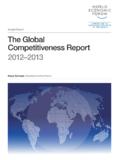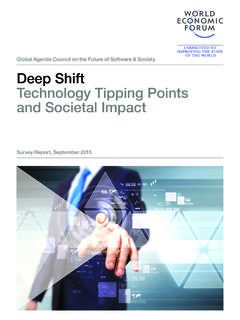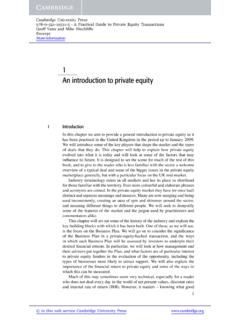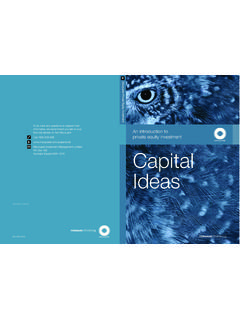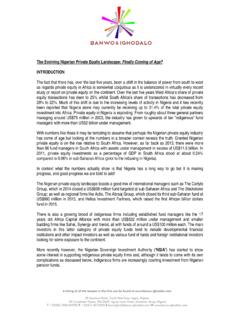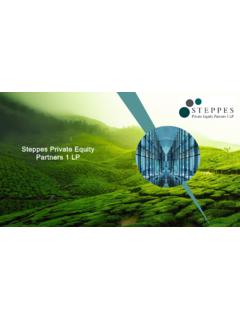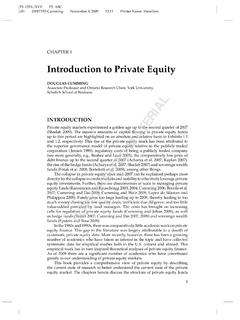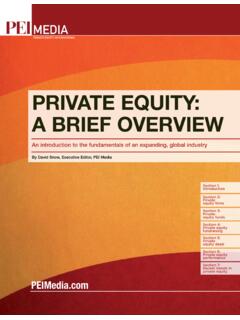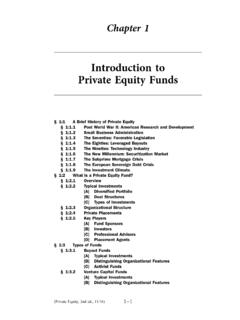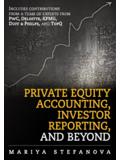Transcription of Alternative Investments 2020 An Introduction to ...
1 July 2015 Alternative Investments 2020 An Introduction to Alternative InvestmentsB Alternative Investments 2020: An Introduction to Alternative Investments World Economic Forum2015 All rights part of this publication may be reproduced or transmitted in any form or by any means,including photocopying and recording, or by any information storage and retrieval Investments 2020: An Introduction to Alternative Investments 1 Introduction and ScopeContentsAccompanying the industry s rise have been recurring worries that hedge funds desta-bilize capital markets, private equity investors load firms with debt, strip their assets, then sell the firms in question, and venture capital firms invest in unicorns that may disappear once they are in the hands of the public. While there are indeed examples of this, short-hand indictments do not do the industry as a whole justice. A robust and educated public debate must form the basis for how we as a society engage with and regulate it.
2 Over the past three decades, the Alternative Investments industry has become a critical component of the global financial system and world economy. Its impact on society can be seen across capital markets, in mainstream businesses and board rooms, and as part of the political discourse. Investors in alternatives now deploy trillions of dollars around the world, playing a critical role in supporting global capital markets, and redistributing risk. The industry has given rise to leading investment firms such as the Blackstone Group, Bridgewater Associates, and Sequoia Capital in the United States, CVC Capital and Brevan Howard in Europe, and The Abraaj Group and many other firms focused on emerging markets. It has owned or funded many well-known companies across a range of industries such as Google, Facebook, Motorola, Heinz, Hertz, and goal of this report is to provide policymakers, regulators, journalists, and the public with an objective overview of the industry in order to better understand the benefits and risks associated with the industry.
3 We believe this is to be a critically important task, given the industry s increasingly central role in the economy and society and the often polarized debate about alternatives. We have aimed, as much as possible, to explain the industry in plain English, but some concepts pre-suppose our reader s fundamental understanding of financial markets and concepts such as liquidity. A list of useful prim-ers on potentially puzzling terms can be found in the appendix. Our hope is that this report clarifies much of the mystery surrounding Alternative Investments , and provides readers with a framework to evaluate facts in a comprehensive report answers some fundamental questions that surround Alternative Investments : What are Alternative Investments ? Why do Alternative Investments exist and why have they grown so rapidly? Where do Alternative investors obtain their capital? How do Alternative investors generate returns?
4 How do Alternative investors interact with the financial system? What benefit do Alternative investors provide to society? Why is Alternative investing so important for the future and what is shaping the industry?We hope this report provides a foundation and starting point for an ongoing dialogue on the role of Alternative Investments . We invite feedback and comments and look forward to a robust and Scope21 Overview of Alternative Definition of Alternative Investment characteristics42A brief history of Alternative Laying the foundations for Alternative Market events93 Investing in Alternative Investment Investment life cycle134 Overview of different types of Alternative Hedge private equity buyouts Venture Other types of Alternative investments185 Sources of Investment Providers of capital216 Sources of Governance Investment Risk Operational Financial engineering257 Role in the financial Product innovation 288 Role in society and the Capital Real economy32 Concluding remarks: A look to the future33 Glossary37 Acknowledgements39 Endnotes1.
5 Overview of Alternative Definition of Alternative investmentsIn its broadest definition, Alternative investment assets are those which are not part of traditional asset classes such as cash, stocks, or bonds that retail investors are most familiar with. Such a definition would encompass investing in mainstream assets such as real estate or commodities or luxury goods such as art or wine. However, for this report, alternatives will be those which have historically utilized distinctive fund structures and which only wealthy individuals and institutions have had access to. Alterna-tives will thus encompass a wide range of asset classes, including private equity real estate and private equity infrastructure funds, secondary funds, and private debt funds. In particular, this report will focus on three asset classes: private equity buyouts, hedge funds, and venture capital. Historically, these three have played the most important role in the evolution of the industry and have accounted for the vast majority of the capital allocated to 1 provides an overview of different types of mainstream and Alternative Investments , while Figure 2 shows how alterna-tives fit into the broader cycle of investing savings into businesses or Investment characteristicsAlternatives offer investors a distinct set of attributes that are not commonly found in mainstream Investments such as public stocks or government or corporate bonds.
6 These typically include one or more of the following attributes: long term, high risk, or illiquid Investments that are associated with higher returns; low correlation with traditional assets to deliver diversification benefits; inflation-hedging benefits; and scalability (the ability to absorb large investment sums). Figure 3 shows the degree to which these and other investment attributes are available to investors in each of the three core Alternative asset of Alternative investmentsFigure 1: Overview of different types of investmentsSource: World Economic Forum Investors Industries2 Alternative Investments 2020: An Introduction to Alternative Investments private equity buyouts Hedge funds Venture capitalCore Alternative investmentsOther Alternative Investments private equity infrastructure private equity real estate private debt funds Other Alternative funds Art Antiquities WineOther investmentsTangible Investments Commodities Real estate Infrastructure Cash Government and corporate bonds Public stocksTraditional investmentsWidely used and accessible to all investors (including retail)Selectively used and only accessible to wealthy individuals and institutional investorsSource: World Economic Forum Investors IndustriesAlternative Investments 2020: An Introduction to Alternative Investments 3 Overview of Alternative investmentsSource.
7 World Economic Forum Investors be saved Personal savings Retirement plans Inheritance Investment income Company earnings Taxes Venture capital private equity buyouts Hedge funds Other ( private debt, infrastructure, etc.) Cash Bank accounts Money market funds Retirement accounts Pension funds Foundations Asset managers Treasuries Companies Governments Real estate Infrastructure Natural resources Individuals Companies Non-profit Governments Start companies Acquire companies Invest in companies Invest in securities Build tangible assets Provide debt Underwrite IPOs Advise on acquisitions Support ..to invest in securities and generatesexcess be invested with use invest-ment stocks, bonds, or tangible assets Figure 2: The investment cycleFigure 3: Expected investment attributes for core Alternative investment asset classesImplications for:PerformanceInvestment attributesTarget returns1 Produces net returns to investorsRiskVariance in returns and risk of losing capitalCorrelation with other assets 2 Correlation with other assets (lower is better)Inflation-linkedThe asset typically adjusts for inflationLiquidityAbility to easily sell the asset when neededScalability 3 Ability to deploy large sums of capital DescriptionVCVCPEPEHFHFVery lowVenture capitalPrivate equity buyoutsHedge fundsVery high1 Over a 10yr horizon; Very high returns = >20%, high = 10-20%, moderate = 5-10%, low = 0-5%, very low = 0%2 Correlation with equity markets.
8 Very high = 80-100%, high = 60-79%, moderate = 40-59%, low = 20-39%, very low = 0-19% 3 The ability of an LP to deploy large amounts of capital efficiently with fund managers and/or in co-investmentsSource: Cambridge Associates, Hedge Fund Research, RREEF, JPMorgan, Coller Capital, Preqin4 Alternative Investments 2020: An Introduction to Alternative Investments 2. A brief history of Alternative investmentPrivate investors, largely in the form of wealthy individuals, have deployed capital in companies since before the Industrial Revolu-tion. However, it was not until the mid to late 20th century that today s Alternative investment industry began to take shape in the United States (Figure 4). The industry has since grown from a handful of firms in the US managing a few billion dollars to thou-sands of firms spread across the world that now manage more than $7 trillion on behalf of investors. The key drivers behind this growth have been regulatory changes and technological innova-tion in the US and global market Laying the foundations for Alternative Regulatory changesThree laws supported the birth and initial growth of the alterna-tives industry and two additional laws enabled the industry to scale up dramatically in the US Small Business Investment Act of 1958: The law sup-ported private investment in small businesses and innovation.
9 It legally enabled the creation of venture capital and private equity buyout fund structures and allowed them to use lever-age. Alternative investors found the legal structures particularly attractive, as fund profits could typically be treated and taxed at lower capital gains rates and not as income, which is usually taxed at higher brief history of Alternative investmentFigure 4: Key moments in the history of Alternative Investments Type of EventRegulationTechnologyMarket eventFirm event11958: US Small Business Investment Act of 1958 Enables the creation of VC and PE fund structures 1972: Kenbak-1 released First personal computer heralds the computing era1973: Black Scholes formula published Enabled the pricing of derivatives1981: Economic Recovery Tax Act of 1981 Made equity Investments more attractive (vs debt)1989: Savings and loan scandal + Drexel Burnham collapsed Junk bond market collapsest1999: Financial Modernization Bill (Gramm-Leach-Bliley Act) Enables the rise of large investment banks in the US1926.
10 Graham-Newman partnership founded First hedge fund1946: American Research and Development Corporation First venture capital fund1962: Investors Overseas Services (IOS) IOS launches first fund of funds1972: Sequoia Capital founded Leading venture capital firm1972: Kleiner Perkins Caufield & Byers founded Leading venture capital firm1975: Bridgewater founded Leading hedge fund1976: KKR founded Leading private equity buyout firm2000s: Rise of sovereign wealth funds Expedites the rise of institutionalization2007: Blackstone IPO First major IPO of a PE firm1920- 60s1978: Update to Employee Retirement Income Security Act of 1974 Allows pension funds to invest in private funds1970s1980s2000s-present2000: Gaussian copula function published Enables the rise of structured products (CDO/CLO/CDS)2008: Global financial crisis Start of a global recession1998: Long-Term Capital implodes Threatens stability of financial system1985: Blackstone founded Leading private equity buyout firm1987: Carlyle founded Leading private equity buyout firm1987: KKR takes over RJR Nabisco Seminal private equity buyout deal2010s: New financial regulations Reshapes the financial and investment industries2000: Commodity Futures Modernization Act of 2000 Enables the growth of derivatives1990s1 The firms referenced here are illustrative examples.




